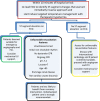Management of ST-Elevation Myocardial Infarction in High-Risk Settings
- PMID: 34025096
- PMCID: PMC8128492
- DOI: 10.1055/s-0041-1723941
Management of ST-Elevation Myocardial Infarction in High-Risk Settings
Abstract
Despite the widespread adoption of primary percutaneous intervention and modern antithrombotic therapy, ST-segment elevation myocardial infarction (STEMI) remains the leading cause of death in the United States and remains one of the most important causes of morbidity and mortality worldwide. Certain high-risk patients present a challenge for diagnosis and treatment. The widespread adoption of primary percutaneous intervention in addition to modern antithrombotic therapy has resulted in substantial improvement in the short- and long-term prognosis following STEMI. In this review, we aim to provide a brief analysis of the state-of-the-art treatment for patients presenting with STEMI, focusing on cardiogenic shock, current treatment and controversies, cardiac arrest, and diagnosis and treatment of mechanical complications, as well as multivessel and left main-related STEMI.
Keywords: STEMI; cardiac arrest; cardiogenic shock; multivessel; myocardial infarction.
International College of Angiology. This article is published by Thieme.
Conflict of interest statement
Conflict of Interest None declared.
Figures
References
-
- American Heart Association Council on Epidemiology and Prevention Statistics Committee and Stroke Statistics Subcommittee . Benjamin E J, Muntner P, Alonso A. Heart Disease and Stroke Statistics-2019 Update: a report from the American Heart Association. Circulation. 2019;139(10):e56–e528. - PubMed
-
- GRACE Investigators . Fox K A, Steg P G, Eagle K A. Decline in rates of death and heart failure in acute coronary syndromes, 1999-2006. JAMA. 2007;297(17):1892–1900. - PubMed
-
- Yeh R W, Sidney S, Chandra M, Sorel M, Selby J V, Go A S. Population trends in the incidence and outcomes of acute myocardial infarction. N Engl J Med. 2010;362(23):2155–2165. - PubMed
-
- American Heart Association Council on Epidemiology and Prevention Statistics Committee and Stroke Statistics Subcommittee . Virani S S, Alonso A, Benjamin E J. Heart Disease and Stroke Statistics-2020 Update: a report from the American Heart Association. Circulation. 2020;141(09):e139–e596. - PubMed
Publication types
LinkOut - more resources
Full Text Sources
Other Literature Sources




